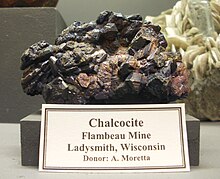Flambeau Mine
 |
|
| Location | |
|---|---|
| Location | Ladysmith |
| WI | |
| Country | United States |
| Coordinates | 45°26′33″N 91°06′55″W / 45.44250°N 91.11528°WCoordinates: 45°26′33″N 91°06′55″W / 45.44250°N 91.11528°W |
| Production | |
| Production | 181,000 tons of copper 334,000 ounces of gold 3.3 million ounces of silver 4.5 million tons of high sulfur waste rock 4 million tons of low sulfur waste |
| Financial year | 1993-1997 |
| Greatest depth | 220 feet |
| History | |
| Opened | 1993 |
| Active | 1993-1997 |
| Closed | 1997 |
| Owner | |
| Website | http://flambeaumine.com/ |
| Year of acquisition | 1969 |
The Flambeau Deposit was discovered in 1969 in Rusk County, Ladysmith, Wisconsin, United States, area and mined between 1993 and 1997.
During the four year operation, the Flambeau Mine produced 181,000 tons of copper, 334,000 ounces of gold and 3.3 million ounces of silver. Under Wisconsin's mining laws, the mine conducted more than 1000 analyses on water samples and treated more than 600 million gallons of water in a state-of-the-art water treatment plant. During construction and operations, 85% of the workforce were local residents. More than 100,000 people visited the mine, taking in the view from the Visitors Center, high above the 181-acre site. Reclamation began in 1997 and since then has been completed. The mine operated on the shores of the Flambeau River, a popular recreation river. The river provides habitat for a variety of aquatic and wildlife species.
Pollution of the surface and ground water was not predicted in the planning and excavating of the mine. There are 48 wells on and surrounding the Flambeau Mine to measure the ground water depth and quality.
The contaminated water that flows into the Flambeau River contains copper, manganese, sulfate and iron that do not threaten the environment. There is no acid in the ground water that moves from the pit into the Flambeau River. The levels of copper, sulfate, manganese and iron in ground water samples are below the levels considered acceptable provided by the DNR.
Surface water runoff from the mine site did not meet Wisconsin surface water quality standards. Runoff is polluting a stream which flows into the Flambeau River. Multiple water samples between 2004 and 2008 show significantly elevated levels of copper, exceeding standards. Studies show that the stream is almost devoid of life, including vegetation and fish. Researchers believe this is because of the high metal levels. At one location, the copper level was approximately 10 times the acute water quality standard, and the zinc level is approximately twice the acute water quality standard. Copper and Zinc combined impact on aquatic organisms is greater than that of either by itself.
In a monitoring well between the pit and the Flambeau River the groundwater did not meet Wisconsin's groundwater quality standards. These contaminants are moving out of the pit. Despite hopes that water infiltration and limestone would neutralize reactions within the pit, monitoring results show that pit reactions had not stabilized. Mine design plans called for the development of a cutoff wall between the pit and the Flambeau River to limit movement of water exiting the pit. It is possible the contaminated water was moving around, under or through the cutoff wall. Another possibility was the bedrock itself is permeable and contaminated water is moving through fractures.
...
Wikipedia

